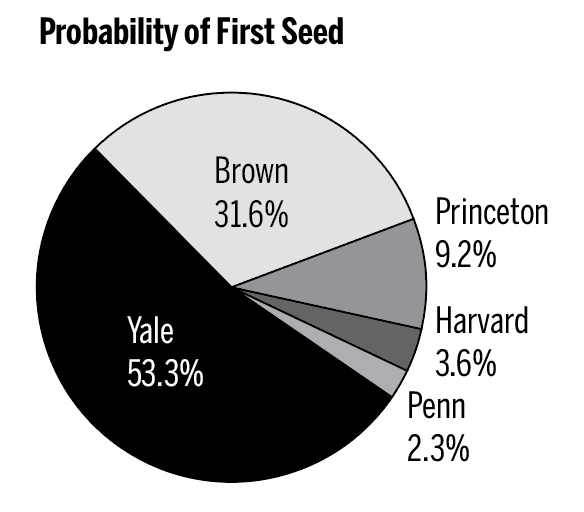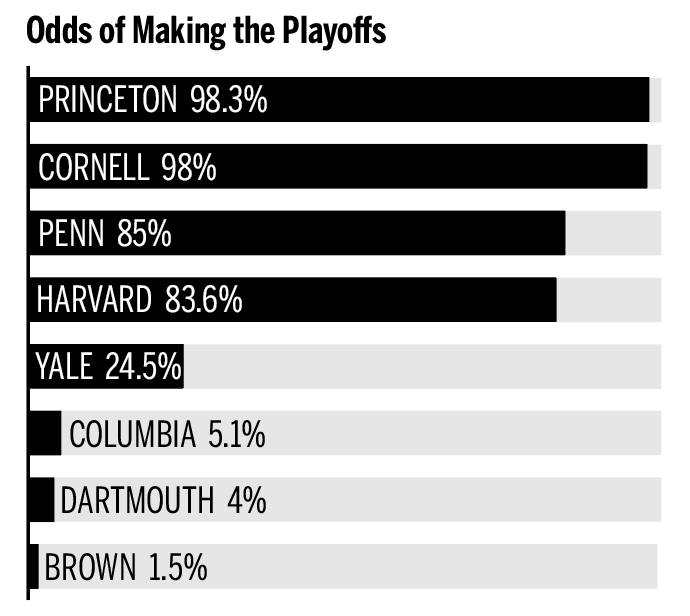With the arrival of spring sports comes an increased spotlight on lacrosse, so we at the Yale Undergraduate Sports Analytics Group built a model that aims to predict the goal differential in a given college lacrosse game.
We collected data from 2014 though this season that includes the scores and location of every NCAA Division I lacrosse game. The data set begins with the current senior class’ rookie season, and the more recent the data is, the higher weight it receives in the model. We use several seasons worth of data because unlike basketball, another sport for which we built a similar prediction system, there simply are not enough games in a single season from which to draw meaningful results.
Our model works by estimating how much of the variation in a team’s results can be explained by its own strength compared to that of its opponents. The model output is a coefficient for each team; taking the difference between two teams’ coefficients yields the predicted goal differential if those two teams were to play at a neutral site. After examining the results of over 4,000 games over the past four seasons, the model determined that, independent of team strength, home-field advantage in college lacrosse is worth about 0.5 goals, which translates to a 3 percent advantage in win probability.
Fortunately for the No. 17 Yale men’s team, our model predicts another successful season for the Bulldogs. Barring injury problems or other extreme circumstances, they can be expected to be make an appearance in the Ivy League tournament this May.

Because of their strong start to the season, including big wins over Princeton and Cornell, Yale currently has the best shot at clinching the No. 1 seed in the four-team postseason tournament. Our model predicts that the Elis have a 53 percent chance of holding the top seed, far ahead of second-place Brown’s 32 percent mark. This position over last year’s regular-season champions could be crucial in deciding the 2017 tournament, since the top seed also hosts the tournament and thus earns home-field advantage.

However, there is still plenty at stake in Yale’s final three conference games. The Bulldogs are favored to win two of these three contests, with the lone exception a much-anticipated April 15 matchup with the Bears.
Though still a long way off, Yale also has the potential to make waves in the NCAA tournament. The model we have created currently ranks the Blue as the 10th-best team in the nation, second only to eighth-ranked Brown in the Ivy League due to the Bulldogs’ struggles in nonconference play.
The road to the Ivy League tournament for the Yale women’s team looks to be a little bit tougher. Four teams — No. 7 Princeton, No. 8 Cornell, No. 9 Penn and Harvard — currently have more than an 80 percent chance of each making the playoffs, meaning it will be difficult for Yale to leap into one of these spots. Our model currently puts the Bulldogs’ odds of a top-four finish and the accompanying postseason berth at 25 percent. Since the introduction of the women’s tournament in 2013, the Bulldogs have yet to make their first appearance in postseason conference play.

After a big win over then-No. 19 Stanford this past Saturday, Yale will likely have to win all or all but one of its remaining four conference games. The Elis are favored to win against Columbia and Dartmouth, which currently combine for just one Ivy League win, but will go in as the underdog against the higher-ranked Tigers and Quakers.
Even though the Bulldogs are not favored in either of these games, our model shows that they have a 40 percent of winning at least one of the two, which could end up making the difference come playoff time. With a strong finish to the season and a little extra luck, the women’s lacrosse team could have the Ivy League tournament in their sights.








